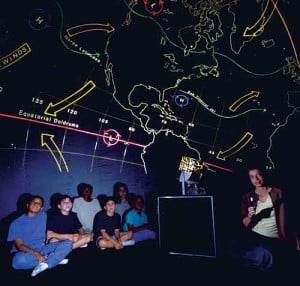
If your kid comes home telling you they’re seeing stars at school, relax, they haven’t been in a fight. It’s the time of year for a portable planetarium called Starlab to be making the rounds of Verona’s elementary schools.
From the outside, the Starlab looks like large gray igloo. When the children step inside the inflated structure–most like to crawl in through the access tunnel–they are treated to a picture of the night sky that most of us don’t get to see any more. A projector inside the dome can display the constellations as they are seen in the Northern or Southern Hemispheres, at different times of year and different times of night. The children can watch an entire evening of stars for northern New Jersey, without donning a heavy coat and hat–or keeping their parents up all night.
“You can teach so many things with it,” says Penny Radosin, a second grade teacher at Laning Avenue School who leads the Starlab activities there. “They can watch Orion travel across the sky. I can use it to explain direction, seasons and time.”
Not to mention a fair amount of classical Greek mythology, since the Starlab can show the constellations as star groupings or as drawings of the legendary people and creatures they were supposed to represent. Science First, the Florida-based company that makes the StarLab, also has imagery for its machines that can teach Native American, African and Hindu mythology, ancient Chinese seasons and legends, Inuit star lore, astronomy and earth science.

Second and third graders spend the most time in the Starlab during its brief visit to Verona each year. (Verona rents its StarLab; the machine costs from $13,000 for an analog model like the one in use here to $39,950 for the digital model.) Kindergarten and first grade classes each get one session in the dome, which can accommodate one classroom of students at a time, and fourth graders get a recap visit. “After they find the stars in here”, Radosin says, “it is easier to find them outside.”
Radosin believes that the Starlab gives students an understanding of the stars that they keep with them for life. “Once you see it”, she says, “you see it forever.”

